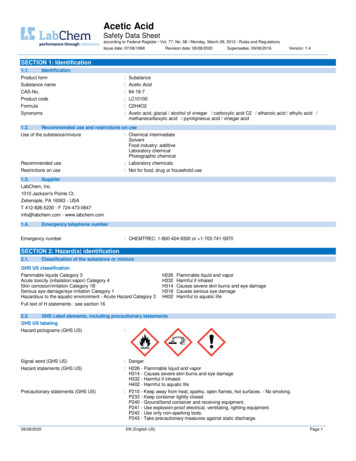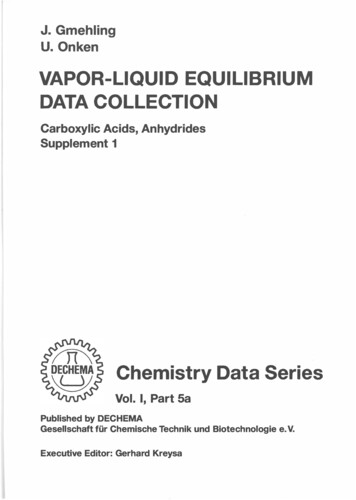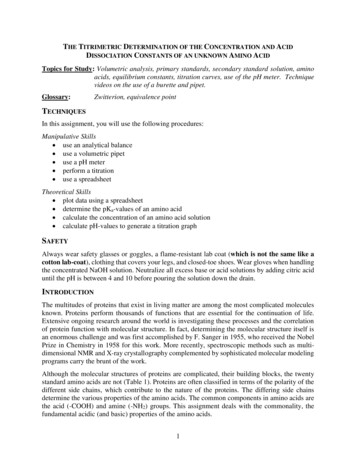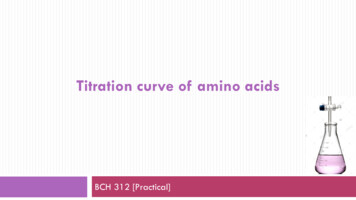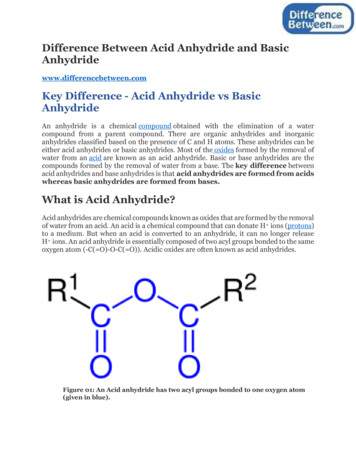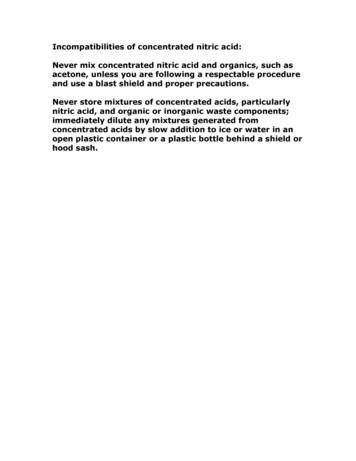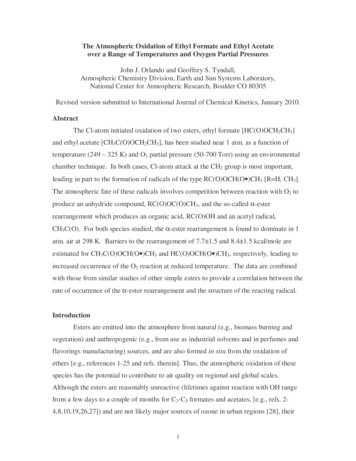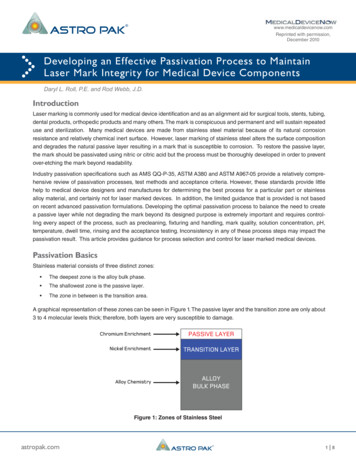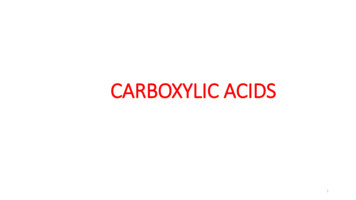
Transcription
Characterization of an Unknown AcidGOAL AND OVERVIEWThe titration curve of an unknown weak acid with a strong base will be measured using a pHmeter. From the titration curve, the equivalence point and the pKa of the acid will be found. Themelting point of the solid acid will be found using a Meltemp. From the experimental values ofmolar mass (as derived from the equivalence point), pKa , and melting point, the identity of theunknown acid will be chosen from a list of possible weak acids.Objectives and Science Skills Perform titrations of an unknown acid solution while recording pH as a function of addedbase. Plot experimental titration data and interpret the graphs to determine the approximate pK aand moles of acid in solution. Use a Meltemp apparatus to determine the approximate melting point of the solid acid. Evaluate the results for molar mass, pK a , and melting point to determine the probableidentify of the unknown acid from a list of choices. Quantitatively and qualitatively compare experimental results with theoretical values. Identify and discuss factors or effects that may contribute to deviations between theoreticaland experimental results and formulate optimization strategies.SUGGESTED REVIEW AND EXTERNAL READING reference section; relevant reference and textbook information on weak acids and basesBACKGROUNDA weak acid is one which does not completely dissociate in water solution. Instead, this equilibrium is established:HA(aq) H2 O(l)A (aq) H3 O (aq) HA(aq)A (aq) H (aq)or, more simply,(1)A– is the conjugate base of the weak acid, HA. Equilibrium is achieved on an extremely short timescale, so that at any time the equilibrium constant expression for the acid dissociation constantwill be satisfied.Ka [H ][A ][HA]c 2011-2015 Advanced Instructional Systems, Inc. and the University of California, Santa Cruz(2)1
The weak acids considered in this lab typically have Ka values that range from about 10-2 to about10-10 .Chemists often express the value of Ka as its negative logarithm, pKa . Substituting the expressionfor Ka and using the properties of logs yields:pKa log Ka log[H ][A ][A ][A ] log [H ] log pH log(3a)[HA][HA][HA]Solving for pH gives:pH pKa log[A ][HA](3b)Eq. 3b (or some algebraic rearrangement of it), is identical in content to Eq. 2 and is commonlycalled the Henderson-Hasselbach Equation. The weak acids considered in this lab typically haveKa values that range from about 10–2 to about 10–10 , or pKa values between 2 and 10. Notice thatthe larger the value of pKa , the weaker the acid.In this experiment, a weak acid will be titrated with the strong base, sodium hydroxide (NaOH).The neutralization reaction of the weak acid by OH is:HA(aq) OH (aq)A (aq) H2 O(4)This reaction is the sum of two simpler reactions:ithe dissociation of the weak acid given in Eq. 1; and,iithe reverse of the self-ionization of water:OH H H2 O(5a)with an equilibrium constant of:1/Kw 1/([OH ][H ]) 1/10 14 1014(5b)Thus, the equilibrium constant for the neutralization of the weak acid by OH (Eq. 4) isKneut Ka[A ] Kw[HA][OH ](6)Since the weak acids used have Ka values between 10–2 and 10–10 , Kneut will lie between 1012c 2011-2015 Advanced Instructional Systems, Inc. and the University of California, Santa Cruz2
and 104 . Thus, the neutralization reaction will essentially go to completion.You will identify your weak acid based on its molar mass and pKa (from points on a titrationcurve), along its approximate melting point.TitrationAs OH is added to HA, the pH of the solution should change approximately as shown in theexample titration curve.Figure 1: Titration Curvei0 mL added NaOH:pH is that of the original acid solution. The dominant equilibrium is HA(aq)H (aq).A (aq) pH is determined primarily by Ka .iiBuffer region:pH changes slowly as NaOH is added. [A ] and [HA] are large relative to the amount ofOH addedKa [H ][A ][HA]where [A ] and [HA] are large and nearly equal(8)The addition of a strong base consumes a small amount of HA to form some more A .The addition of a strong acid would consume a small amount of A to form some more HA.[A ]/[HA] remains relatively constant so pH shows little change.c 2011-2015 Advanced Instructional Systems, Inc. and the University of California, Santa Cruz3
iii1/2 Vequiv1/2:the volume required to neutralize the acid has been added.Approximately 1 /2 [HA]initial has reacted to form A . [HA] [A ] and pH pKa .pH pKa log[A ];[HA]at [HA] [A ], log[1] 0 and pH pKa(9)iv Vequiv :pH increases as the equivalence point is neared.At Vequiv , nOH nHA MOH VOH . pH 6 7 due to A H2 OHA OH equilibrium.The mass in grams of HA titrated divided by the moles of HA present gives the molar massof HA.vAbove Vequiv :Adding more OH raises the pH. There is a sharp jump in pH above the equivalence volume,Vequiv .Melting Point DeterminationThe melting point of your acid is another one of its distinguishing characteristics. Melting pointsare tabulated for many substances; in practice, a solid will melt over a small range in temperature.There can be a variety of reasons for this, including impurities or rapid heating. The observeduncertainty in the melting point can be as much as 5 to 10 C. Although melting point data can besomewhat unreliable, it provides further information regarding your acid’s identity.PROCEDURECAUTION: You are working with unknown organic compounds. Handle themwith caution and wash them off your skin.Part 1a: Obtaining the Titration Curve of an Unknown Acid1Obtain a vial of unknown weak acid and record its number.2Weigh out roughly 0.30 g of the acid and determine its mass to 0.0001 g (analytical balance).3Some acids are soluble in water; others are not. On your vial of unknown, there should beeither an “a” or a “w”.If your vial has an “a”, follow this procedure (dissolve in alcohol):iPut the solid acid into a 250 mL beaker.iiPour 20 mL of alcohol from a graduated cylinder into your beaker.c 2011-2015 Advanced Instructional Systems, Inc. and the University of California, Santa Cruz4
iii Gently swirl for a minute or two to dissolve all the acid in the pure alcohol solution. Bewareof alcohol evaporating on the sides of the beaker after the swirling. Do not heat the alcoholbecause alcohol is flammable.iv Add about 80 mL of distilled water, washing the sides of the beaker down with the waterso that all of the acid sample is titrated. The total volume should be about 100 mL.If your vial has a “w”, follow this procedure (dissolve in water):iDissolve the acid in 100 mL of distilled water.iiYou may have to heat the water to get the acid to dissolve.Titration:Follow the procedure outlined for buret usage. Be sure your buret is clean and the stopcocksare firmly seated.CAUTION: Do not fill burets on the work-bench. Always keep all chemicals below eyelevel. This decreases the chance of getting chemicals in your eye in the event of a spill.For practice:1Put some water in the buret and practice controlling the stopcock.2If you have air bubbles in the buret, gently knock the bottom of the buret to free themso they can rise to the surface.3You will determine the volume of titrant delivered by subtracting the initial buret reading from the final (volume by difference).4Mount the buret on the stand. In real titrations, you would put a white towel or pieceof paper over the dark base of the ring stand so the color change of the indicator willbe easy to see. Since this is a practice, your titrant is water. You’re just practicing thestopcock control and volume reading. The goal is to get a feel for the buret.5Practice reading the volume (liquid level at the bottom of the meniscus). Take readingsto 0.01 or 0.02 mL.6Record the initial volume of water. Add water to a collection flask and read the newvolume. Find the volume of water added by difference.7Practice by delivering a milliliter, a few drops, and one drop.c 2011-2015 Advanced Instructional Systems, Inc. and the University of California, Santa Cruz5
Figure 2Part 1b: Titrating the weak acid1Calibrate the pH meter as instructed. You must set the temperature to room temperature anddo a two-point calibration.2Set up a 50-mL buret filled with NaOH titrant. Record the molarity of the NaOH to foursignificant figures.3Set the beaker of acid solution on the magnetic stirrer, add the stir bar, and stir slowly. Thestir bar should not hit the pH probe.4Record the initial solution pH (to two decimal places) and the initial buret reading to 0.05 mL.5Titrate the sample with NaOH using the pH meter to follow the titration.6Add NaOH in about 1 mL amounts. Record pH and the buret reading with each addition.c 2011-2015 Advanced Instructional Systems, Inc. and the University of California, Santa Cruz6
7When there is a larger-than-usual pH change upon the addition of 1 mL base, reduce the volumeto 0.5 mL additions.8When the pH increases quickly, add the NaOH drop-wise. The region of the big pH jump iswhere the equivalence point lies. Continue drop-wise additions of NaOH until you have gonebeyond the big pH jump by about 1 mL. Then go back to 0.5 mL and eventually to 1 mLadditions.9Continue adding NaOH until the pH is above 11.10 Do a second titration.11 Plot each titration curve (pH of the solution vs. volume of NaOH added). Draw a single, smoothline through the data points. Your curve should look similar to the example given. Discussyour results with your TA before you leave. You may want to repeat part of the experiment.Select the better titration curve (more closely resembles the example and gives results that areconsistent with the acid choices indicated by your TA). Use this curve as the basis for yourresults. Use average values if you have good titration curves.12 Record the volume of NaOH at the equivalence point to three significant figures. Calculatethe moles of acid originally present in the sample that you titrated. Report this value to threesignificant figures. At the equivalence point, nOH nHA (molarity of NaOH)(volume ofNaOH added).13 Divide the mass of your sample (four significant figures) by the calculated number of moles(three significant figures) to find the molar mass of your acid to three significant figures.14 Read the pH at the 1 /2 equivalence volume to two decimal places. This is an approximate valueof pKa for your acid.Part 2: Determining the melting point1Obtain two pieces of thin-walled capillary tubing that are sealed at one end.2To fill a capillary tube, press its open end into a pulverized sample of the unknown acid. About1 or 2 mm of powder in the tube is sufficient. You need enough to see the transformation fromsolid to liquid, but too much will give a large melting point range.3Obtain a long piece of glass tubing (the ‘bounce tube’).4To pack the crystals into the bottom of the capillary tube, hold the bounce tube so that it isresting on the work bench. Drop the capillary tube (closed side down) inside the bounce tube.The capillary tube should hit the bench with enough force to pack the crystals but not enoughto break the tube. It is also possible to just tap the capillary tube on the lab bench. Your TAcan demonstrate.5Use the 0 – 260 C thermometer for the melting point. A thermometer should already be in themeltemp device. Use caution with the thermometer (it is bad if it breaks, particularly insidethe meltemp).c 2011-2015 Advanced Instructional Systems, Inc. and the University of California, Santa Cruz7
6Place one capillary tube in the meltemp as instructed. You should be able to view the solid acidthrough the window. Get an approximate melting point range by increasing the temperaturefairly slowly. Use your judgment on the rate.7When you find an approximate melting point range, place the second capillary tube in themeltemp. Turn the control so that the temperature slowly rises up to the actual melting point.You should record the temperature at which you first see liquid (to the ones place), as wellas the temperature at which the sample completely liquefies (to the ones place). You need anaccurate melting point range: Tfirst liquid to Tall melted .Take the average value and report it asam approximate melting point temperature (to the ones place).8Each sample can only be melted once. Do not reuse any sample that has been melted.9Dispose of the used capillary tubes in the appropriate container in the back fume hood. Donot put capillary tubes in the trash.Cleanup:Follow your TA’s instructions. *Nothing should go into the trash*In the back fume hood, there should be:a liquid waste container for the solutions from the titration trialsa solid waste container for the remaining weak acid (in its vial) and for the used capillarytubesPart 3: Identifying your acidWith experimental values of molar mass, pKa , and melting point, identify your acid from the list.Figure 3You can discuss many things in this experiment. If you want to go beyond the minimum, youcould do some interesting calculations using your experimental equilibrium constant. For example,you could use Eq. 3b, the Henderson-Hasselbach equation, to calculate the pH at 25%, 50%, and75% of the equivalence point, and compare with your experimental titration curve. Also calculatethe equilibrium constant for the titration reaction (Kneut ) using the Ka of your unknown acid.REPORTING RESULTSc 2011-2015 Advanced Instructional Systems, Inc. and the University of California, Santa Cruz8
Complete your lab summary or write a report (as instructed).ResultsM M (unknown acid)pKaTm.p.name of acidSample Calculations:Molar MassDiscussionWhat you found out and how for each partWhat was your unknown acid and whyReviewc 2011-2015 Advanced Instructional Systems, Inc. and the University of California, Santa Cruz9
Part 1a: Obtaining the Titration Curve of an Unknown Acid 1 Obtain a vial of unknown weak acid and record its number. 2 Weigh out roughly 0.30 g of the acid and determine its mass to 0.0001 g (analytical balance). 3 Some acids are soluble in water; others are not. On your vial of unknown, there should be either an \a" or a \w".
